List of monarchs of Malta
The Mediterranean islands of Malta and Gozo have been ruled by Phoenician, Byzantine and Roman aristocrats, before passing to various European monarchies. Foreign monarchical rule over Malta lasted a total of 874 years. The Crown of Malta was "patriated" for the first time in 1964, with the achievement of Independence.
.svg.png.webp)
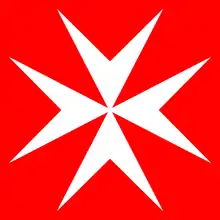
The history, languages and culture of Malta and Sicily share many key events, including occupation by the Fatimids and an invasion by Roger I of Sicily in 1091. The islands parted ways in a decisive and permanent manner in 1799, when Malta became a British Crown colony. British rule over Malta lasted 165 years and for a further 10 years, Malta retained the British monarch as its own independent head of state. Malta adopted a Republican constitution in 1974 and joined the European Union on 1 May 2004.[1]
Kingdom of Sicily and County of Malta
.svg.png.webp)
From the years 1090 and 1530, the Maltese Islands were a non-autonomous part of the Kingdom of Sicily and thus had the same sovereign. At this time the Nobility of Malta resided in or around Mdina. A strong cultural (and, to a lesser extent, political) connection to Sicily survived from 1530 to 1798 throughout the 268-year rule over Malta by the Knights Hospitaller.
In terms of the regional divisions of the islands, Malta Island was part the Valle di Mazzara province, Gozo was part of the Valle di Demona province and Comino was part of the Valle di Noto province.
Counts of Malta
- Roger I of Sicily (1091-1101), conqueror of Malta
- Simon of Sicily (1101-1105)
- Roger II of Sicily (1105-1154)
- William I of Sicily (1154-1166)
- William II of Sicily (1166-1189)
- Tancred of Sicily (1189-1190)
- Margaritus of Brindisi (1192-1197)
- Guglielmo Grasso (c.1197-1203)
- Enrico "Pescatore" (c.1203-1232)
- Nicoloso (c.1232-1266)
- Charles I of Naples (direct rule 1266-1282), usurper during the Sicilian vespers; with Nicoloso as claimant (1266-1281)
- Andreolo da Genova (1282-1300), with Roger de Flor as claimant (1285-1296)
- Roger of Lauria (1300-1305)
- Lukina de Malta and her husband Guglielmo Raimondo I (1305-1320)
- Guglielmo II (c.1320-1330)
- Alfonso Federigo d'Aragona (c.1330-1349)
- Pietro Federigo d'Aragona (c.1349-1350)
- Louis of Sicily (direct rule 1350-1355)
- Frederick the Simple (direct rule 1355-1360), with Niccolo Acciaioli as claimant (c.1357-1360)
- Guido Ventimiglia (c.1360-1362)
- Frederick the Simple (direct rule 1362-1366)
- Manfredo III Chiaramonte (c.1366-1370)
- Guglielmo III d'Aragona (c.1370-1377)
- Luigi Federigo d'Aragona (1377-1382)
- Manfredo III Chiaramonte (1382-1391)
- Elizabetta Peralta Chiaramonte (c.1391-1392)
- Guglielmo Raimondo III Moncada (c.1392-1393)
- Artale II Alagona (c.1393-1396/1398)
- Guglielmo Raimondo III Moncada (c.1396-1397)
- Maria of Sicily (direct rule 1397-1401) with her husband Martin I of Sicily (direct rule by jure uxoris 1397-1409)
- Martin of Aragon (direct rule 1409-1410)
- Ferdinand I of Aragon (direct rule 1412-1416)
- Alfonso V of Aragon (direct rule 1416-1420)
- Antonio de Cardona (c.1420-1425)
- Gonsalvo Monroy (c.1426-1428),[2][3]
- Alfonso V of Aragon (1428-1458)
- John II of Aragon (1458-1479)
- Ferdinand II of Aragon (1479-1516)
- Charles V, Holy Roman Emperor (1516-1530)
Knights Hospitaller (1530–1798)
Although the Knights Hospitaller ruled Malta as sovereign princes, they held that privilege as a fiefdom, paying a tribute of the Maltese Falcon annually to the Viceroys of Sicily, payable on the feast of All Souls' Day.
France
- Occupied by French First Republic (1798–1800)
British Crown (1799–1964)
House of Hanover
| Name | Portrait | Birth | Marriages | Death |
|---|---|---|---|---|
| George III 1799–1820 | 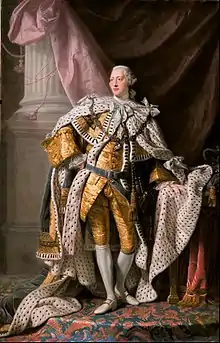 | 4 June 1738 Norfolk House son of Frederick, Prince of Wales and Princess Augusta of Saxe-Gotha | Charlotte of Mecklenburg-Strelitz St James's Palace 8 September 1761 15 children | 29 January 1820 Windsor Castle aged 81 |
| George IV 29 January 1820–1830 |  | 12 August 1762 St James's Palace son of George III and Charlotte of Mecklenburg-Strelitz | (2)[4] Caroline of Brunswick St James's Palace 8 April 1795 1 daughter | 26 June 1830 Windsor aged 67 |
| William IV 26 June 1830–1837 | 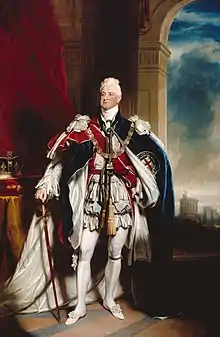 | 21 August 1765 Buckingham Palace son of George III and Charlotte of Mecklenburg-Strelitz | Adelaide of Saxe-Meiningen Kew Palace 13 July 1818 2 children | 20 June 1837 Windsor Castle aged 71 |
| Victoria 20 June 1837–1901 | 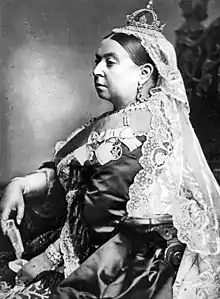 | 24 May 1819 Kensington Palace daughter of Prince Edward Augustus, Duke of Kent and Strathearn and Princess Victoria of Saxe-Coburg-Saalfeld | Albert, Prince Consort St James's Palace 10 February 1840 9 children | 22 January 1901 Osbourne House aged 81 |
House of Saxe-Coburg-Gotha
| Name | Portrait | Birth | Marriages | Death |
|---|---|---|---|---|
| Edward VII 22 January 1901–1910[5] | 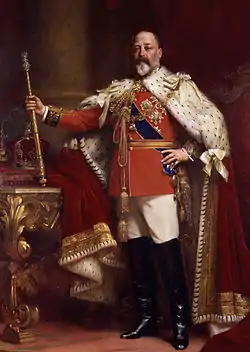 | 9 November 1841 Buckingham Palace son of Victoria and Albert, Prince Consort[6] | Alexandra of Denmark Windsor Castle 10 March 1863 6 children[6] | 6 May 1910 Buckingham Palace aged 68[6] |
House of Windsor
The house name Windsor was adopted in 1917, during the First World War. It was changed from Saxe-Coburg-Gotha because of wartime anti-German sentiment. The heirs of Elizabeth II, by royal proclamation, will remain part of the House of Windsor (even though their legal surname is Mountbatten-Windsor).
| Name | Portrait | Birth | Marriages | Death |
|---|---|---|---|---|
| George V 6 May 1910–1936[7] | 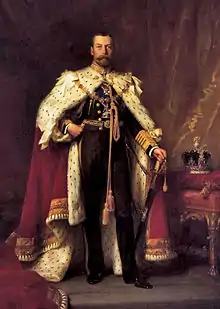 | 3 June 1865 Marlborough House son of Edward VII and Alexandra of Denmark[8] | Mary of Teck 6 July 1893 St James's Palace 6 children[9] | 20 January 1936 Sandringham House aged 70[8] |
| Edward VIII 20 January – 11 December 1936[10] | 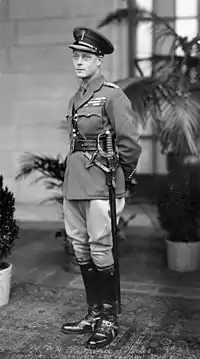 | 23 June 1894 Richmond son of George V and Mary of Teck[10] | Wallis, The Duchess of Windsor France 3 June 1937 no children[10] | 28 May 1972 Paris aged 77[11] |
| George VI 11 December 1936–6 February 1952[12] | .jpg.webp) | 14 December 1895 Sandringham House son of George V and Mary of Teck[12] | Elizabeth Bowes-Lyon Westminster Abbey 26 April 1923 2 children[13] | 6 February 1952 Sandringham House aged 56[14] |
| Elizabeth II 6 February 1952–1964[15] | 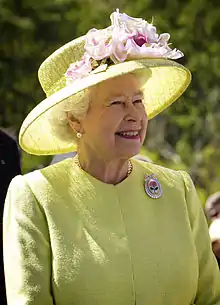 | 21 April 1926 Mayfair daughter of George VI and Elizabeth Bowes-Lyon[16] | Prince Philip, Duke of Edinburgh Westminster Abbey 20 November 1947 4 children[17] |
Crown of Malta (1964–1974)
| Name | Portrait | Birth | Marriages | Death |
|---|---|---|---|---|
| Elizabeth II, Queen of Malta (Reġina ta' Malta) 1964–1974[15] |  | 21 April 1926 Mayfair daughter of George VI and Elizabeth Bowes-Lyon[16] | Prince Philip, Duke of Edinburgh Westminster Abbey 20 November 1947 4 children[17] |
Malta acquired independence from the United Kingdom on 21 September 1964, but the Queen of the United Kingdom, Elizabeth II, remained Queen of Malta. On 13 December 1974, Malta became a republic, and since that date, its head of state has been the President of Malta.
References
- "The History of the European Union – 2000-today". Archived from the original on 11 October 2007. Retrieved 12 October 2007.
- De Lucca Denis, Mdina A history of its urban space and architecture, Said International, 1995, p. 126
- Dalli Charles, Malta The Medieval Millennium, Midsea Books Ltd, 2006, p. 98,152,155,168,182,183,188
- George IV first married Maria Anne Fitzherbert on 15 September 1785, but the marriage was void.
- NNDB Profile of Edward VII. URL last accessed on 21 January 2007.
- Royal Genealogies Archived 11 June 2012 at the Wayback Machine. URL last accessed on 21 January 2007.
- King George V. URL last accessed 21 January 2006.
- House of Windsor – George V. URL last accessed 21 January 2006.
- Mary of Teck. URL last accessed 21 January 2006.
- House of Windsor – Edward VIII. URL last accessed 23 March 2008.
- Royal Government's The House of Windsor – Edward VIII. URL last accessed 21 January 2006.
- House of Windsor – George VI. URL last accessed 21 January 2006.
- Elizabeth Bowes-Lyon: The Indomitable Queen Mum. URL last accessed 21 January 2006.
- King George VI dies in his sleep. URL last accessed 21 January 2006.
- BBC Historic Figures – Elizabeth II. URL last accessed 21 January 2006.
- House of Windsor – Elizabeth II. URL last accessed 21 January 2006.
- BBC Historic Encyclopædia Britannica Guide to Women's History – Elizabeth II. URL last accessed 21 January 2006.
